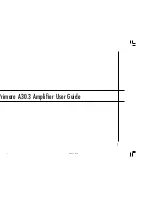
KA BAND OUTDOOR TWT AMPLIFIER
4-6
Table 4-1 Notes
:
1. Outputs are dry-circuit relay contacts rated up to 50 V
DC
, 50 mA.
2. External interlocks and RF Inhibit inputs are optically isolated. Maximum open
circuit voltage present is 16 V
DC
. Typical operating current is 3 mA.
3. The RF Inhibit requires a maintained closed-contact with RF Inhibit return for
normal operation. (An open will cause a RF Inhibit.) This RF Inhibit command is
executed regardless of the current control mode.
4.
The External Interlocks (both Latching and Non-latching) require a maintained
closed-contact with their respective interlock returns for normal operation. (An
open will cause either a Fault or RF Inhibit condition.)
5.
Pins ‘R’ through ‘Y’ are used only when the Switch Option has been installed.
6. For alternate switch configuration options, such as 1:2 or Hybrid Switch Options,
Table 4-1 does not apply.
4.4 Ethernet Interface
This interface allows amplifier to be accessed via 10BASE-T Ethernet. Refer to Table 4-2 for
optional drawings. This interface has the following functionality:
•
Monitoring and control of the amplifier via TCP using the ASCII Based CIF protocol
and the STX/ETX header/ending byte message format, using TCP port 50000.
•
Monitoring and control of the amplifier via a Java based application, which provides
access to meters, trip-point settings, meter log and switch configuration.
•
Downloading and programming the amplifier Control System flash memory via FTP.
•
Synchronize the amplifiers internal clock to GMT via UDP.
•
Browse the amplifier to monitor Status, Meter Readings, and Latched Fault History.
•
Browse the amplifier to configure the four E-Mail Groups that permits the Amplifier to
send E-Mail to the recipients in the list if any of the configured events have occurred.
INSTALLATION AND OPERATION MANUAL
















































